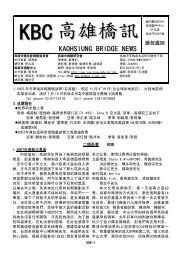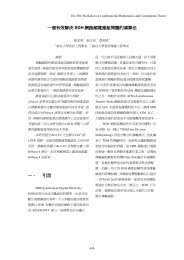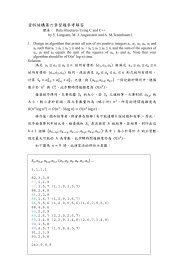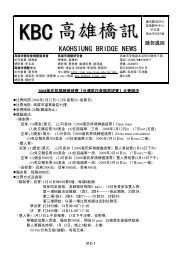The Weighted All-Pairs-Shortest-Path-Length Problem on Two ...
The Weighted All-Pairs-Shortest-Path-Length Problem on Two ...
The Weighted All-Pairs-Shortest-Path-Length Problem on Two ...
You also want an ePaper? Increase the reach of your titles
YUMPU automatically turns print PDFs into web optimized ePapers that Google loves.
<str<strong>on</strong>g>The</str<strong>on</strong>g> 25th Workshop <strong>on</strong> Combinatorial Mathematics and Computati<strong>on</strong> <str<strong>on</strong>g>The</str<strong>on</strong>g>ory<br />
L 2<br />
+ L[j, a], L[b, j] + [j, i] + L[i, a],<br />
L[b, i] + OL[i, j] + L[j, a], L[b, j] +<br />
OL[j, i] + L[i, a]};<br />
break;<br />
case v , v ∈ V(G(f))<br />
a<br />
b<br />
L[a, b] = min{L[a, b],<br />
L[a, i] + [i, j] + L[j, b],<br />
L 1<br />
L[a, j] + L 1<br />
[j, i] + L[i, b],<br />
L[a, i] + OL[i, j] + L[j, b],<br />
L[a, j] + OL[j, i] + L[i, b]};<br />
L[b, a] = min{L[a, b], L[b, i] + [i, j] + L[j,<br />
L 1<br />
L 1<br />
a], L[b, j] + [j, i] + L[i, a], L[b, i] +<br />
OL[i, j] + L[j, a], L[b, j] + OL[j, i] +<br />
L[i, a]};<br />
break;<br />
case ( v ∈ V(G(q)) and v ∈ V(G(f))) or ( v ∈<br />
a<br />
V(G(f)) and<br />
v b<br />
b<br />
∈ V(G(q)))<br />
L[a, b] = min{L[a, i] + L[i, b],<br />
L[a, j] + L[j, b],<br />
L[a, i] + OL[i, j] + L[j, b],<br />
L[a, j] + OL[j, i] + L[i, b]};<br />
L[b, a] = min{L[b, i] + L[i, a],<br />
L[b, j] + L[j, a],<br />
L[b, i] + OL[i, j] + L[j, a],<br />
L[b, j] + OL[j, i] + L[i, a]};<br />
break;<br />
endcase<br />
endfor<br />
2<br />
Lemma 7: Phase III can be d<strong>on</strong>e in O( n )-time.<br />
<str<strong>on</strong>g>All</str<strong>on</strong>g> reas<strong>on</strong>ing and results so far can easily imply<br />
the following theorem.<br />
<str<strong>on</strong>g>The</str<strong>on</strong>g>orem 1: <str<strong>on</strong>g>The</str<strong>on</strong>g> weighted APSPL problem <strong>on</strong><br />
2<br />
TTSP graphs can be solved in O( n ) time.<br />
4. C<strong>on</strong>clusi<strong>on</strong>s<br />
In [8], the authors shown that APSPL problem <strong>on</strong><br />
planar graphs with n<strong>on</strong>negative edge-weights can be<br />
2<br />
solved in O( n ) time. But the time-complexity so<strong>on</strong><br />
7<br />
3<br />
increases to O( n log( nL)<br />
) if negative<br />
edge-weights are allowed, where L is the absolute<br />
value of the most negative edge-weight. <str<strong>on</strong>g>The</str<strong>on</strong>g> class of<br />
TTSP graphs is a vital subclass of the class of planar<br />
graphs. This paper has established a meaningful<br />
improvement: the WAPSPL problem <strong>on</strong> TTSP<br />
2<br />
graphs can be solved in O( n ) time. Our algorithm<br />
a<br />
⎛n⎞<br />
is time-optimal in worst case since there are ⎜ ⎟ =<br />
⎝ 2⎠<br />
2<br />
O( n ) pairs of distinct vertices in any graph G.<br />
In the future, it is very important and worthy to<br />
extend our result to the classes of graphs with the<br />
property m = O(n), such as planar graphs. In another,<br />
studying the WAPSPL <strong>on</strong> other classes of graphs<br />
such as bipartite graphs, permutati<strong>on</strong> graphs, is also<br />
a practical and interesting issue.<br />
References<br />
[1] P. D’ Alberto and A. Nicolau, “R-Kleene: A<br />
High-Performance Divide-and-C<strong>on</strong>quer<br />
Algorithm for the <str<strong>on</strong>g>All</str<strong>on</strong>g>-Pair <str<strong>on</strong>g>Shortest</str<strong>on</strong>g> <str<strong>on</strong>g>Path</str<strong>on</strong>g> for<br />
Densely C<strong>on</strong>nected Networks”, Algorithmica,<br />
Vol. 47, pp. 203-213, 2007.<br />
[2] E. Cohen, “Polylog-Time and Near-Linear<br />
Work Approximati<strong>on</strong> Scheme for Undirected<br />
<str<strong>on</strong>g>Shortest</str<strong>on</strong>g> <str<strong>on</strong>g>Path</str<strong>on</strong>g>s”, Journal of the ACM, Vol. 47,<br />
No. 1, January 2000.<br />
[3] E. W. Dijkstra, “A Note <strong>on</strong> <strong>Two</strong> <str<strong>on</strong>g>Problem</str<strong>on</strong>g>s in<br />
C<strong>on</strong>nexi<strong>on</strong> with Graphs”, Numerische<br />
Mathematik, Vol. 1, pp. 269-271, 1959.<br />
[4] R. J. Duffin, “Topology of Series-Parallel<br />
Networks”, J. Math., Appl. 10, pp. 303-318,<br />
1965.<br />
[5] M. L. Fredman and R. E. Tarjan, “Fib<strong>on</strong>acci<br />
Heaps and <str<strong>on</strong>g>The</str<strong>on</strong>g>ir Uses in Improved Network<br />
Optimizati<strong>on</strong> Algorithms”, Journal of ACM,<br />
Vol. 34, pp. 596-615, 1987.<br />
[6] M. L. Fredman and D. E. Willard,<br />
“Trans-dichotomous Algorithms for Minimum<br />
Spanning Trees and <str<strong>on</strong>g>Shortest</str<strong>on</strong>g> <str<strong>on</strong>g>Path</str<strong>on</strong>g>s”, Journal of<br />
Computer and System Sciences, Vol. 48, pp.<br />
533-551, 1994.<br />
[7] Y. Han, “Improved Algorithm for <str<strong>on</strong>g>All</str<strong>on</strong>g> <str<strong>on</strong>g>Pairs</str<strong>on</strong>g><br />
<str<strong>on</strong>g>Shortest</str<strong>on</strong>g> <str<strong>on</strong>g>Path</str<strong>on</strong>g>s”, Informati<strong>on</strong> Processing<br />
Letters, Vol. 91, pp. 245-250, 2004.<br />
[8] M. R. Henzinger, P. Klein, S. Rao, and S.<br />
Subramanian, “Faster <str<strong>on</strong>g>Shortest</str<strong>on</strong>g>-<str<strong>on</strong>g>Path</str<strong>on</strong>g><br />
Algorithms for Planar Graphs”, Journal of<br />
Computer and System Sciences, Vol. 55, Iss. 1,<br />
pp. 3-23, 1997.<br />
[9] C-W Ho and J-M Chang, “Solving <str<strong>on</strong>g>The</str<strong>on</strong>g><br />
<str<strong>on</strong>g>All</str<strong>on</strong>g>-pairs-shortest-length <str<strong>on</strong>g>Problem</str<strong>on</strong>g> <strong>on</strong> Chordal<br />
Bipartite Graphs”, Informati<strong>on</strong> Processing<br />
Letters, Vol. 69, pp. 87-93, 1999.<br />
[10] R. H. Jan, L. H. Hsu, and Y. Y. Lee, “<str<strong>on</strong>g>The</str<strong>on</strong>g><br />
Most Vital Edges with Respect to the Number<br />
of Spanning Trees in <strong>Two</strong>-Terminal<br />
Series-Parallel Graphs”, Bit, Vol. 32, pp.<br />
403-412, 1992.<br />
[11] T. Kikuno, N. Yoshida, and Y. Kakuda, “A<br />
Linear Algorithm for the Dominati<strong>on</strong> Number<br />
-360-







